If you own a 3D printer, then, chances are, you’ve heard the scary rumors that they spread toxic fumes into the air. But is this true? Do 3D printers emit dangerous fumes?
The answer is not really. While every 3D printer produces fumes that aren’t good for your lungs and body, the amount of these air-born contaminants is far too low to harm you most of the time.
However, you shouldn’t leave your health up to chance, so it’s still a good idea to ventilate your 3D printer. Ventilating a 3D printer involves enclosing it and adding an air vent, air filter, or air purifier to ensure none of the fumes end up in your lungs.
Of course, you can ventilate your 3D printer in a few ways, from using a HEPA filter to installing a vent tube to a window. In this article, we’ll go over all of the best ways you can ventilate your enclosed 3D printer, along with a ton of other information concerning the safety of 3D printing.

What Type of Fumes Does a 3D Printer Emit?
The majority of the “fumes” that a 3D printer emits fall into either:
- Ultrafine particles
- Volatile organic compounds (VOCs)
1. Ultrafine Particles
Ultrafine particles are tiny physical particles that float around in the air after being released as a byproduct of the 3D printer melting filament material or curing resin. Typical 3D printer ultrafine particles are smaller than 0.1 microns – for reference, a single spot of dust is 25 microns.
Despite their small size, ultrafine particles can be very dangerous, and can cause irritation and inflammation in your lungs, as well as other health problems.

2. VOCs
Volatile organic compounds, known as VOCs, are organic chemicals that have a high vapor pressure, and can easily turn into a gas or vapor to turn airborne. VOCs are what can make 3D printers smell and, if you noticed actual fumes coming from your 3D printer, it probably was a collection of VOCs in the air.
Just like ultrafine particles, VOCs are tiny, and are typically released when your 3D printer heats filament (or resin). When the nozzle melts the plastic, it releases various gases (VOCs in airborne form).
Examples of the specific VOCs released into the air from a 3D printer include benzene, acrolein, formaldehyde, and many others.
It is important to recognize that these VOCs can cause health issues. Long-term exposure to high levels of VOCs can cause headaches, dizziness, and irritation to the eyes, nose, and throat.
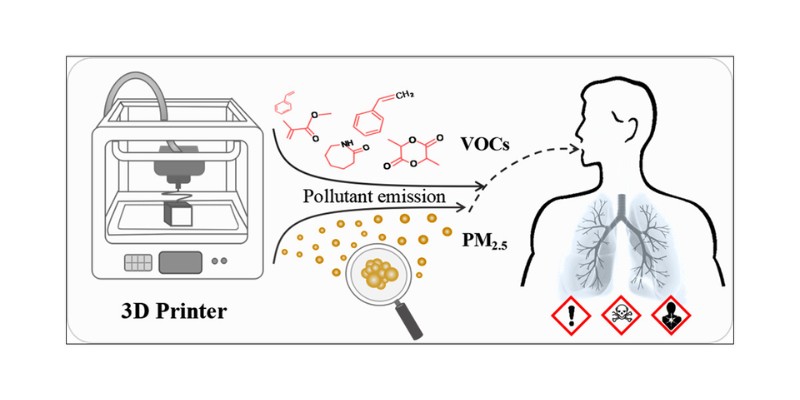
It’s also worth noting that different 3D printing technologies and materials have varying levels of VOC emissions. For example, FDM 3D printing tends to emit more VOCs than resin 3D printing. PLA also releases fewer VOCs than ABS, mostly because ABS requires higher print temperatures.
With all of this in mind, it’s important that you properly ventilate your 3D printer and avoid the risks, even if they are small.
Risks and Effects from Poorly Ventilated 3D Printer
So what happens if you don’t ventilate your 3D printer and you simply inhale all of the fumes it produces?
Realistically, nothing.
If you’re a healthy human with a functional respiratory system, then it’s very unlikely that occasionally inhaling low levels of toxic fumes from a 3D printer will cause any long-term health problems. For most people, the worst thing that can happen from not ventilating their 3D printer is a headache every now and then.
However, researchers from the EPA and the Georgia Institute of Technology have found that 3D printers can produce some more dangerous airborne contaminants that have been linked to severe, long-term health problems, like organ damage and lung cancer.

As such, it’s better to be safe than sorry, and take the time to properly ventilate your 3D printer.
How to Properly Ventilate Your 3D Printer
To ensure that your 3D printer is properly ventilated, first, make sure the machine is in an enclosure. Then, consider adding an air vent or an air filter to the enclosure so that any fumes from the machine are moved outside or absorbed properly.
Here’s my six recommendations more detail:
1. Use an enclosure
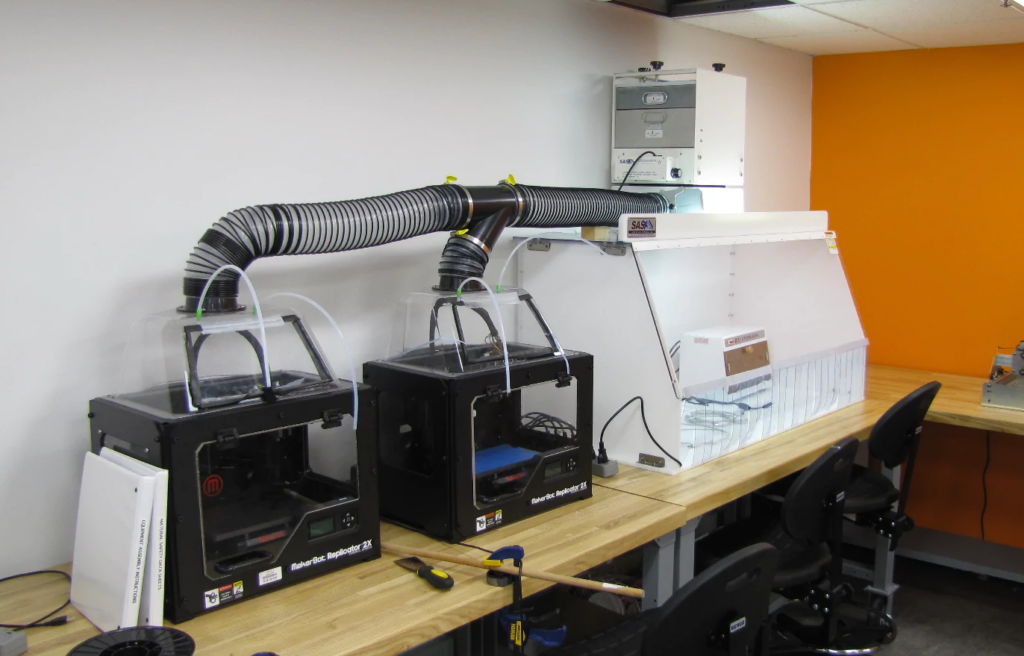
Firstly, you should make sure you have an enclosure for your 3D printer.
An enclosure encompasses your 3D printer, helping to trap heat around the build area, while also preventing air drafts from ruining your prints. Enclosures enable you to print high-temperature filament materials, like ABS and ASA, while also improving the overall quality of your prints (regardless of material).
On top of the printing benefits, enclosures also help prevent harmful fumes from entering your lungs. While enclosures don’t rid an area of airborne contaminants, it traps them in a contained space so they don’t travel to every nook and cranny of your house or workspace.
There are many great options for 3D printer enclosures, including both DIY projects and purchasable products. We have an in-depth article all about the best 3D printer enclosures which I recommend reading, as well as our article on the best enclosed 3D printers.
2. Add a vent to the enclosure
Once you have an enclosure, I strongly recommend adding a 3D printer vent to the inside of the chamber. One side of the vent should be connected to the inside of your (sealed) 3D printer enclosure, while the other side should connect either to a purification system or an outdoor window.
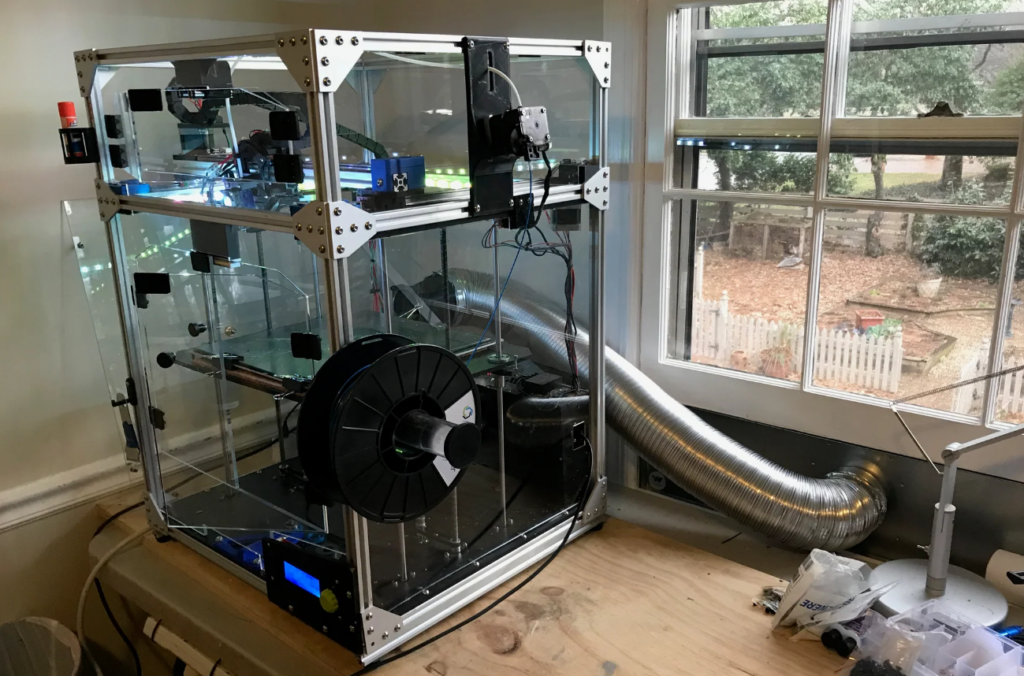
By making a DIY 3D printer ventilation system, you’re allowing the air inside the enclosure to flow out, so there will be a constant circulation of fresh, uncontaminated air. Adding a low-power fan to the vent is also a good idea, so you can circulate the air after every print.
3. Place your printer in a well-ventilated room
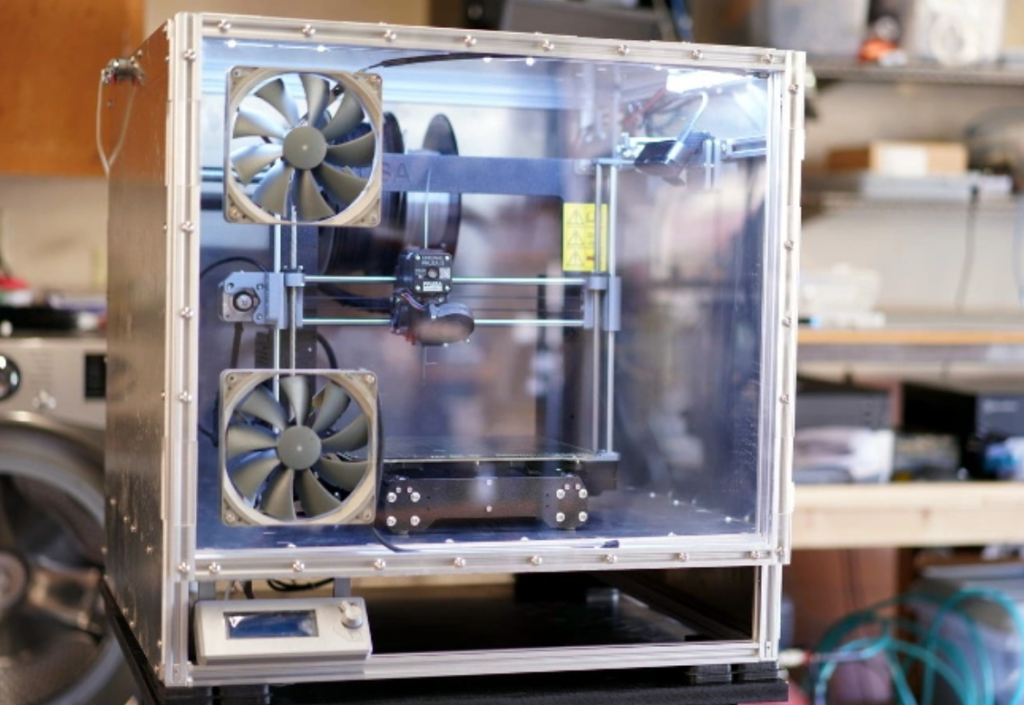
Of course, even the best 3D printer enclosure might still leak some fumes. Placing your printer (and its enclosure) in a well-ventilated room ensures that any leftover fumes are cleared out quickly, reducing the amount of contaminants that enter your lungs.
So how can you achieve proper ventilation in a room? Well, the easiest way is simply to turn on the air conditioning and leave the door open.
However, to be even safer, you can purchase a standalone air purifier device and leave it running in whatever room you’ve placed your printer. I’ll recommend some air purifiers later in this article.
4. Use an air filter
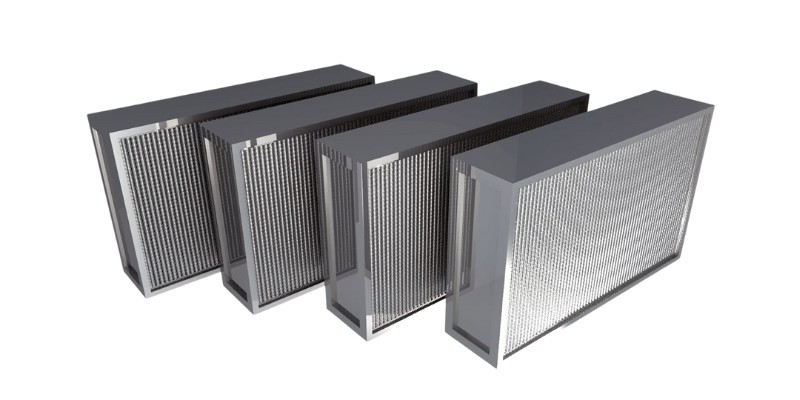
Air filters are stationary sponge-like devices, made up of layers of special fibers that absorb airborne contaminants so you don’t breathe them in.
There are a handful of different types of air filters, but for 3D printers, the two best types are HEPA filters and activated carbon filters. HEPA filters are great at removing ultrafine particles from the air, while carbon-activated filters work their magic on VOCs.
It’s important to note that, while using only one type of filter will still help, the best way to reduce health risks is to use both HEPA and carbon-activated filters.
As for where to put them, anywhere inside your 3D printer’s enclosure is a good spot. Just make sure it doesn’t interfere with the machine’s moving parts!
5. Use materials that produce less fumes
Another thing you can do to limit your 3D printer’s toxic emissions is to select your filament material (or resin material) wisely, as different filaments emit different levels of fumes.
For example, PLA plastic emits significantly lower levels of toxic fumes when melted than ABS, hence the noticeable smell when printing ABS filament. For more information, you can read our guide to the best PLA filaments.
6. Use protective equipment
Lastly, if you’re really adamant about avoiding inhaling toxic fumes, then you can also use protective equipment, such as a filtered air mask. Of course, you could use a disposable COVID mask, but a reusable mask, equipped with air filters, is a better option. You can find one of these types of masks at basically any hardware store or online.
Compared to the other solutions listed, using personal protective equipment is a bit of a hassle. But, if you get headaches around your 3D printer, this can help a lot.
Use These Air Purifiers To Prevent Toxic 3D Printer Fumes
Air purifiers, not to be confused with an air filter, actively purify the air in a room. Air purifiers are a good way to ensure that, even if some toxic fumes leak out of your printer’s enclosure, you can still safely live and breathe in whatever room you’ve placed your printer.
Here’s two I recommend:
Levoit LV-H133 Air Purifier

Levoit’s LV-H133 Air Purifier is a household air purifier perfect for removing your 3D printer’s emissions from the air.
Equipped with a built-in HEPA filter, the LV-H133 will remove any ultrafine particles from the air. There are two other filters inside the purifier, including an activated carbon filter (for the VOCs) and a nylon filter for any other contaminants.
While the Levoit LV-H133 is a bit pricy, costing just over $200, it’s super reliable and fast. Levoit claims the LV-H133 clears out ~99.7% of the contaminants in the air within 30 minutes.
So, if you’re committed to ensuring that no one in your household is breathing in bad air, I strongly recommend the Levoit LV-H133. Its three filters are more than capable of handling the emissions from multiple 3D printers, and it’s super fast.
Blueair’s Blue Pure 211+
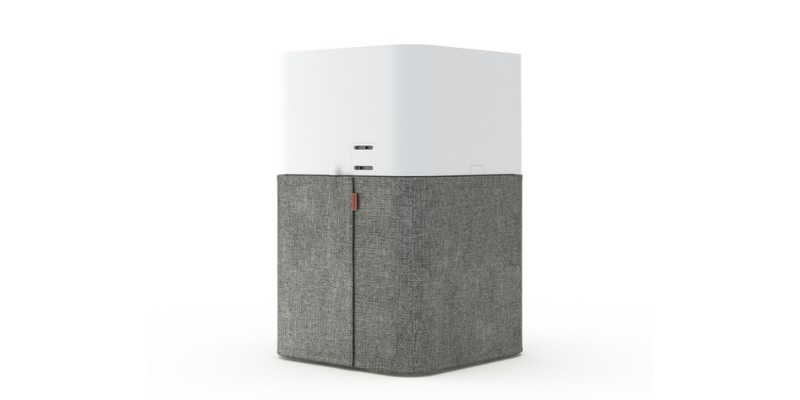
The Blue Pure 211+ is another terrific air purifier that’s more than capable of handling a 3D printer’s emissions. It’s a bit more expensive than the Levoit LV-H133, but it has some additional features that make the higher price tag worth it.
It’s very quiet, with a maximum noise level of just 35 dB, so it will be like a faint whisper even when it’s working its hardest.
On another note, the Blue Pure 211+ has multiple filters built-in. On top of its special HEPA filter which removes ultrafine particles from the air, the Blue Pure 211+ has pre-filters that can handle VOCs and pollen.
So, if you want the purest, cleanest air in your 3D printer workspace, check out Blueair’s Blue Pure 211+.
FAQs:
How do you ventilate an enclosed 3D printer?
The best way is to add a vent tube on one side of the enclosure, and connect the other side of the tube to a window. With this setup, the VOCs, dust, and other air-born contaminants inside your 3D printer chamber can be flushed outside. Another good idea is to add an air filter inside your 3D printer enclosure, to further prevent contaminants from getting into your lungs.














